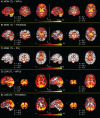Functional localization of the human auditory and visual thalamus using a thalamic localizer functional magnetic resonance imaging task
- PMID: 40800539
- PMCID: PMC12315755
- DOI: 10.1162/imag_a_00360
Functional localization of the human auditory and visual thalamus using a thalamic localizer functional magnetic resonance imaging task
Abstract
Functional magnetic resonance imaging (fMRI) of the auditory and visual sensory systems of the human brain is an active area of investigation in the study of human health and disease. The medial geniculate nucleus (MGN) and lateral geniculate nucleus (LGN) are key thalamic nuclei involved in the processing and relay of auditory and visual information, respectively, and are the subject of blood-oxygen-level-dependent (BOLD) fMRI studies of neural activation and functional connectivity in human participants. However, localization of BOLD fMRI signal originating from neural activity in MGN and LGN remains a technical challenge, due, in part, to the poor definition of boundaries of these thalamic nuclei in standard T1-weighted and T2-weighted magnetic resonance imaging sequences. Here, we report the development and evaluation of an auditory and visual sensory thalamic localizer (TL) fMRI task that produces participant-specific functionally-defined regions of interest (fROIs) of both MGN and LGN, using 3 Tesla multiband fMRI and a clustered-sparse temporal acquisition sequence, in less than 16 minutes of scan time. We demonstrate the use of MGN and LGN fROIs obtained from the TL fMRI task in standard resting-state functional connectivity (RSFC) fMRI analyses in the same participants. In RSFC analyses, we validated the specificity of MGN and LGN fROIs for signals obtained from primary auditory and visual cortex, respectively, and benchmarked their performance against alternative atlas- and segmentation-based localization methods. The TL fMRI task and analysis code (written in Presentation and MATLAB, respectively) have been made freely available to the wider research community.
Keywords: auditory processing; functional localizer task; lateral geniculate; medial geniculate; resting-state functional connectivity; visual processing.
© 2024 The Authors. Published under a Creative Commons Attribution 4.0 International (CC BY 4.0) license.
Conflict of interest statement
A.A.-D. received consulting fees and/or honoraria from Sunovion Pharmaceuticals Inc., Otsuka Pharmaceutical Co., Ltd., Merck & Co., Inc., Neurocrine Biosciences, Inc., F. Hoffmann-La Roche AG, and C.H. Boehringer Sohn AG & Co. KG. A.A.-D. holds stock options in Herophilus, Inc. and in Terran Biosciences, Inc. All other authors declare that they have no known competing financial interests or personal relationships that could have influenced or appear to have influenced the work reported in this paper.
Figures






Update of
-
Functional Localization of the Human Auditory and Visual Thalamus Using a Thalamic Localizer Functional Magnetic Resonance Imaging Task.bioRxiv [Preprint]. 2024 Oct 18:2024.04.28.591516. doi: 10.1101/2024.04.28.591516. bioRxiv. 2024. Update in: Imaging Neurosci (Camb). 2024 Nov 12;2:imag-2-00360. doi: 10.1162/imag_a_00360. PMID: 38746171 Free PMC article. Updated. Preprint.
References
-
- Almasabi , F. , Janssen , M. L. F. , Devos , J. , Moerel , M. , Schwartze , M. , Kotz , S. A. , Jahanshahi , A. , Temel , Y. , & Smit , J. V. ( 2022. ). The role of the medial geniculate body of the thalamus in the pathophysiology of tinnitus and implications for treatment . Brain Res , 1779 , 147797 . 10.1016/j.brainres.2022.147797 - DOI - PubMed
-
- American Psychiatric Association . ( 2000. ). Diagnostic and statistical manual of mental disorders: DSM-IV-TR ( 4th ed., text revision. ed.). American Psychiatric Association; . ISBN: 9780890420621. https://books.google.co.in/books/about/Diagnostic_and_Statistical_Manual...
-
- American Psychiatric Association . ( 2013. ). Diagnostic and statistical manual of mental disorders: DSM-5 ( 5th ed.). American Psychiatric Association; . 10.1176/appi.books.9780890425596 - DOI
LinkOut - more resources
Full Text Sources
